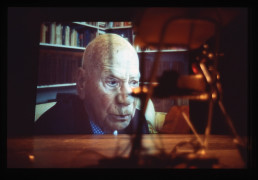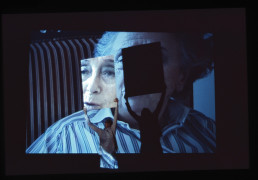“HISTOIRE(S)”
Olga de Soto
Em Junho de 2003, a convite de António Pinto Ribeiro, no âmbito do programa Homenagem a Le Jeune Homme et la Mort, que evocava o bailado estreado em Paris em Junho de 1946 no Théatre des Champs Elysées, com libreto de Jean Cocteau, coreografia de Roland Petit e memorável interpretação do bailarino Jean Babilée, a coreógrafa Olga de Soto criou para a Culturgest História (primeira versão), apresentada num espetáculo partilhado com o compositor Luís Tinoco (Imaginary Landscape – a melodrumming after Cocteau) e com o coreógrafo Hervé Robbe (REW – vers une utopie du renoncement).
Depois destas apresentações em Lisboa, Olga de Soto continuou a desenvolver o projeto, que deu origem à performance-documentário histoire(s) estreado em 2004 no Kunstenfestivaldesarts, em Bruxelas que, desde então, tem circulado por toda a Europa com enorme sucesso, e agora apresentamos.
Trata-se do resultado de uma pesquisa sobre o que perdura de um espetáculo da dança na memória dos espectadores, com recurso aos comoventes testemunhos filmados de alguns espectadores mais de meio século após terem assistido às primeiras apresentações de Le Jeune Homme et la Mort em 1946, no imediato pós-guerra.
Ficha técnica
Conceito, Direção e Coreografia Olga de Soto
Criado com Vincent Druguet
Intérpretes Cyril Accorsi e Olga de Soto
Realização vídeo, Câmara e Som Olga de Soto
Testemunhos de Micheline Hesse, Suzanne Batbedat, Robert Genin, Brigitte Evellin, Julien Pley, Françoise Olivaux, Olivier Merlin e Frédéric Stern
Montagem vídeo Montxo de Soto e Olga de Soto
Música Johann Sebastian Bach, Sarabanda da Suite inglesa nº2 BWV 807, Sarabanda da Suite inglesa nº5 BWV 810, Passacaglia em dó menor BWV 852 (transcrição para piano) interpretadas ao piano por Angela Hewitt (CDA67309 & CDA67451/2 Hyperion Records Ltd London)
Cenografia Thibault Vancraenenbroeck
Desenho de luz Henri-Emmanuel Doublier
Direção técnica Christophe Gualde
Produção NIELS (Bruxelas)
Coprodução Kunstenfestivaldesarts, Centre National de la Danse (Pantin)
Apoio COM4 HD (Madrid), Ministère de la Communauté Française Wallonie (Bruxelas) – Secteur Danse
Responsável pela digressão Caravan Production (Bruxelas)
Agradecimentos Catherine Alvès, Odette Aslan, Dominique Baguette, Michèle Bargues, Suzanne Batbedat, Pierre Caizergues, Jean-Jacques Chabut, Sybille Cornet, Cécile Coutin et Simone Drouin (Département des Arts du Spectacle de la Bibliothèque de l’Arsenal – Paris), Eugénie De Mey, François Deppe, Ramón de Soto, Eliane Dheygere, Brigitte Evellin, Dominique Frétard, Robert Genin, Carlos González, Micheline Hesse, Colin Legras, Francis Lepigeon, Olivier Merlin, Nadine vzw – Bruxelas, Stéphane Noël, Françoise Olivaux, Jean Robin, Frédéric Stern, Superamas, Théâtre de la Balsamine, Michel Troadec, Georges Alexander Van Dam, Gaëtan van den Berg, Marie-Christine Vernay e Christophe Wavelet
Agradecimentos especiais Marc Bouteiller, Nathalie Collantès, Hyperion Records Ltd, Olivier Hespel, Jorge León, Manuela Gutiérrez, Luis Sanz, Olivier Tiremarche, Grégoire Romefort e a Antón
“HISTOIRE(S)”
Olga de Soto
In June 2003, with the invitation of António Pinto Ribeiro, under the program Homage to Le Jeune Homme et la Mort, which evoked the ballet premiered in Paris, in June 1946, at the Théatre des Champs Elysées, with a libretto by Jean Cocteau, a choreography by Roland Petit and a memorable performance by the dancer Jean Babilée, the choreographer Olga de Soto created for Culturgest História (primeira versão), presented in a show shared with the composer Luís Tinoco (Imaginary Landscape – a melodrumming after Cocteau) and the choreographer Hervé (REW – vers une utopie du renoncement).
Following these presentations in Lisbon, Olga de Soto continued to develop the project, which gave rise to the documentary-performance histoire(s) premiered in 2004 at the Kunstenfestivaldesarts in Brussels, which has since been touring throughout Europe with great success, and which we now present.
It is the result of a research about what remains of a dance performance in the memory of the spectators, using the touching testimonies filmed by some spectators more than half a century later after attending the first performances of Le Jeune Homme et la Mort in 1946, in the immediate postwar period.
Credits
Concept, Diretion and Choreography Olga de Soto
Created with Vincent Druguet
Performers Cyril Accorsi and Olga de Soto
Video directing, Camera and Sound Olga de Soto
Testimonies Micheline Hesse, Suzanne Batbedat, Robert Genin, Brigitte Evellin, Julien Pley, Françoise Olivaux, Olivier Merlin and Frédéric Stern
Video editing Montxo de Soto and Olga de Soto
Soundtrack Johann Sebastian Bach, Sarabande from the English suite nº2 BWV 807, Sarabande from the English suite nº5 BWV 810, Passacaglia in C minor BWV 852 (transcripted to piano) played on the piano by Angela Hewitt (CDA67309 & CDA67451/2 Hyperion Records Ltd London)
Scenography Thibault Vancraenenbroeck
Lighting design Henri-Emmanuel Doublier
Technical direction Christophe Gualde
Production NIELS (Brussels)
Co-production Kunstenfestivaldesarts, Centre National de la Danse (Pantin)
Support COM4 HD (Madrid), Ministère de la Communauté Française Wallonie (Brussels) – Secteur Danse
Tour manager Caravan Production (Brussels)
Acknowledgements Catherine Alvès, Odette Aslan, Dominique Baguette, Michèle Bargues, Suzanne Batbedat, Pierre Caizergues, Jean-Jacques Chabut, Sybille Cornet, Cécile Coutin and Simone Drouin (Département des Arts du Spectacle de la Bibliothèque de l’Arsenal – Paris), Eugénie De Mey, François Deppe, Ramón de Soto, Eliane Dheygere, Brigitte Evellin, Dominique Frétard, Robert Genin, Carlos González, Micheline Hesse, Colin Legras, Francis Lepigeon, Olivier Merlin, Nadine vzw – Brussels, Stéphane Noël, Françoise Olivaux, Jean Robin, Frédéric Stern, Superamas, Théâtre de la Balsamine, Michel Troadec, Georges Alexander Van Dam, Gaëtan van den Berg, Marie-Christine Vernay and Christophe Wavelet
Special acknowledgements Marc Bouteiller, Nathalie Collantès, Hyperion Records Ltd, Olivier Hespel, Jorge León, Manuela Gutiérrez, Luis Sanz, Olivier Tiremarche, Grégoire Romefort and Antón

